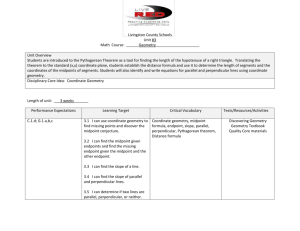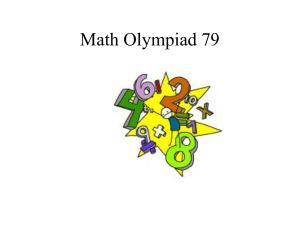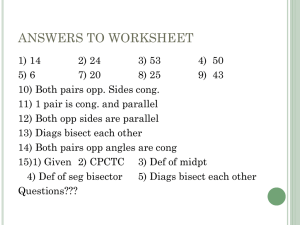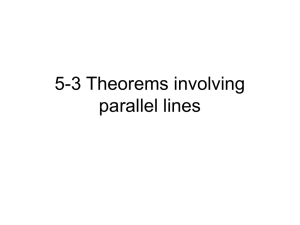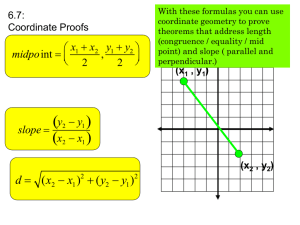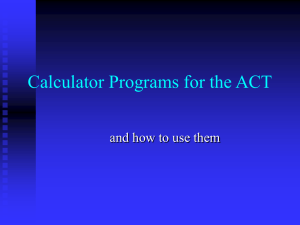LESSON PLAN
advertisement
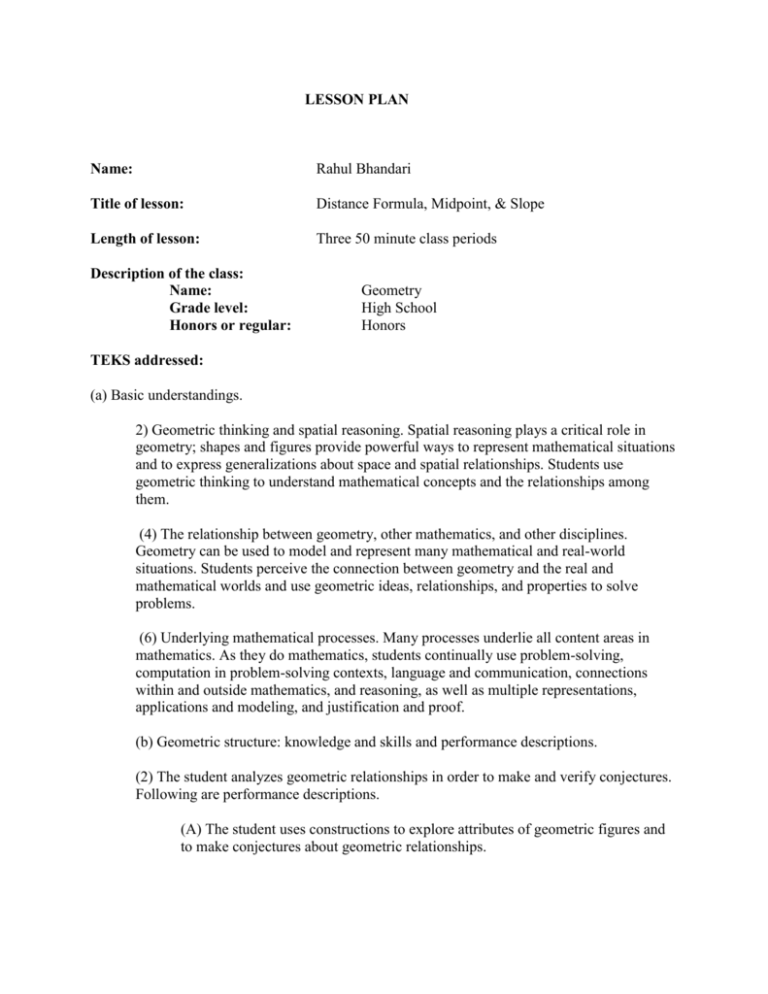
LESSON PLAN Name: Rahul Bhandari Title of lesson: Distance Formula, Midpoint, & Slope Length of lesson: Three 50 minute class periods Description of the class: Name: Grade level: Honors or regular: Geometry High School Honors TEKS addressed: (a) Basic understandings. 2) Geometric thinking and spatial reasoning. Spatial reasoning plays a critical role in geometry; shapes and figures provide powerful ways to represent mathematical situations and to express generalizations about space and spatial relationships. Students use geometric thinking to understand mathematical concepts and the relationships among them. (4) The relationship between geometry, other mathematics, and other disciplines. Geometry can be used to model and represent many mathematical and real-world situations. Students perceive the connection between geometry and the real and mathematical worlds and use geometric ideas, relationships, and properties to solve problems. (6) Underlying mathematical processes. Many processes underlie all content areas in mathematics. As they do mathematics, students continually use problem-solving, computation in problem-solving contexts, language and communication, connections within and outside mathematics, and reasoning, as well as multiple representations, applications and modeling, and justification and proof. (b) Geometric structure: knowledge and skills and performance descriptions. (2) The student analyzes geometric relationships in order to make and verify conjectures. Following are performance descriptions. (A) The student uses constructions to explore attributes of geometric figures and to make conjectures about geometric relationships. (B) The student makes and verifies conjectures about angles, lines, polygons, circles, and three-dimensional figures, choosing from a variety of approaches such as coordinate, transformational, or axiomatic. The Lesson: I. Overview The goal of this lesson is to have students determine the distance formula and relate this to the equation of a circle. Students will determine the formulas for midpoint and slope. This will be done through problem-solving. II. Performance or learner outcomes The students will be able to: determine the distance formula and be able to relate this to the equation of a circle. Also, students will determine the formulas for midpoint and slope. III. Resources, materials and supplies needed Rulers IV. Supplementary materials, handouts. Handout for Homework—Attached Day 1 Five-E Organization Teacher Does Engage: Learning Experience Quickly review Pythagorean Theorem. (assess prior knowledge) Set up problem that asks students to find formula for the shortest distance between 2 points. Questions 1. What is the formula for the Pythagorean Theorem? 2. What kind of triangles is this for? 3. What is the shortest way to get from Wal-Mart to Target? Student Does Student Activity Students are listening and answering questions. Expected Student Answers 1. c2 = a2 + b2 2. right triangles 3. a straight line Evaluate Teacher will make sure students are on task and participating. Teacher Does Explore: Learning Experience(s) Teacher is walking around to each group assessing their progress. Student Does What the students are doing Students are working in groups to discover the distance formula. Questions Expected Student Answers 1. What approach are you using to 1. Answer will vary depending on solve this problem? group. Evaluate The teacher will walk around the room to assess each groups’ progress. Day 2 Teacher Does Explain: Learning Experience(s) Teacher is listening to students’ ideas. Calling on different students to give their opinions. Questions Questions will depend on students’ approaches. Teacher will summarize his/her approach to help students grasp the concept. Teacher’s Approach: Questions: 1. What is the first thing we have to do? 2. What formula do you have to use to find the distance formula? 3. Show different triangles and ask if the theorem can be applied to them. 4. How do you know to use this theorem? (Have them say which sides are a, b, and c.) Student Does What the students are doing Groups are presenting their work. Students are listening and correcting their mistakes. Expected Student Answers Students will answer depending on the question. Expected Student Answers 1. Graph the points. 2. The Pythagorean Theorem. 3. No 4. The intersection made it a right triangle. 5. What problem do you have using this? 6. How do you find the side lengths so you can use the theorem? 7. How do you use this to find the side length? 8. Call two students to demonstrate distance between two horizontal or vertical points. 9. How do you use these and the Pythagorean Theorem to find the distance formula? 10. So, what is the distance formula? 5. No side lengths were given. 6. By labeling the points. (x1, y1) and (x2, y2) 7. x2-x1 is one side and y2-y1 is the other. 8. demonstrating distance. 9. By plugging in a=x2-x1, b=y2-y1, and c is what we are looking for. 10. c2=(x2-x1)2 + (y2-y1)2 Evaluate The teacher will ask questions to guide the review and the steps to take to find the formula. Teacher Does Student Does Extend / Elaborate: Learning Experience(s) If time permits, show students how this formula relates to the equation for a circle. Teacher will assign worksheet for homework extra practice. What the students are doing Students are listening and paying attention to teacher. Students are excited to use the new approach to find out the distance between two points. Evaluate Each student is looking at the questions and thinking about how they will solve them at home. Day 3 Five-E Organization Teacher Does Engage: Learning Experience Reintroduce graph from first day. Reflect on constructing a perp. line with a compass to show them the midpoint. Questions 1. How do you draw a perpendicular line recalling the lesson on Friday? (have them explain) Student Does Student Activity Students are listening and answering questions. Expected Student Answers 1. With a compass. Students will explain how. 2. Is there a midpoint on this line? 2. Yes, the point where the perp. line and the original line intersect. 3. A point half-way between two points on a line. 4. Slant—rate of change. 3. What is a midpoint? 4. Can anyone define slope? 5. Think about the slope of this line. Can you find it? 5. Students will get into groups. Evaluate Teacher will make sure students are on task and participating. Teacher Does Explore: Learning Experience(s) Teacher is walking around to each group assessing their progress. Student Does What the students are doing Students are working in groups to discover the midpoint formula. Once a group has it, teacher will okay to move on to finding the slope formula. Questions Expected Student Answers 1. What approach are you using to 1. Answer will vary depending on solve this problem? group. Evaluate The teacher will walk around the room to assess each group’s progress. Teacher Does Explain: Learning Experience(s) Teacher is listening to students’ ideas. Calling on different students to give their opinions. Questions Questions will depend on students’ approaches. Teacher will summarize his/her approach to help students grasp the concept. Student Does What the students are doing Groups are presenting their work. Expected Student Answers Students will answer depending on the question. Students are listening and correcting their mistakes. Explain that we rise before we run. (example of stairs) Teacher’s Approach: Expected Student Answers Questions: 1. Students are paying attention. 1. Teacher will give a real life example to explain midpoint concept. 2. What is the formula for the 2. x=(x1+x2)/2 and y=(y1+y2)/2 midpoint? 3. What does the slope tell us? 3. rate of change 4. What is the formula for the slope? 4. (y2-y1)/(x2-x1) Evaluate The teacher will ask questions to guide the review and the steps to take to find the formula. Teacher Does Extend / Elaborate: Learning Experience(s) Teacher will assign worksheet for homework extra practice. Student Does What the students are doing Students are excited to use the new approach to find midpoint and slope. Evaluate Each student is looking at the questions and thinking about how they will solve them at home.
